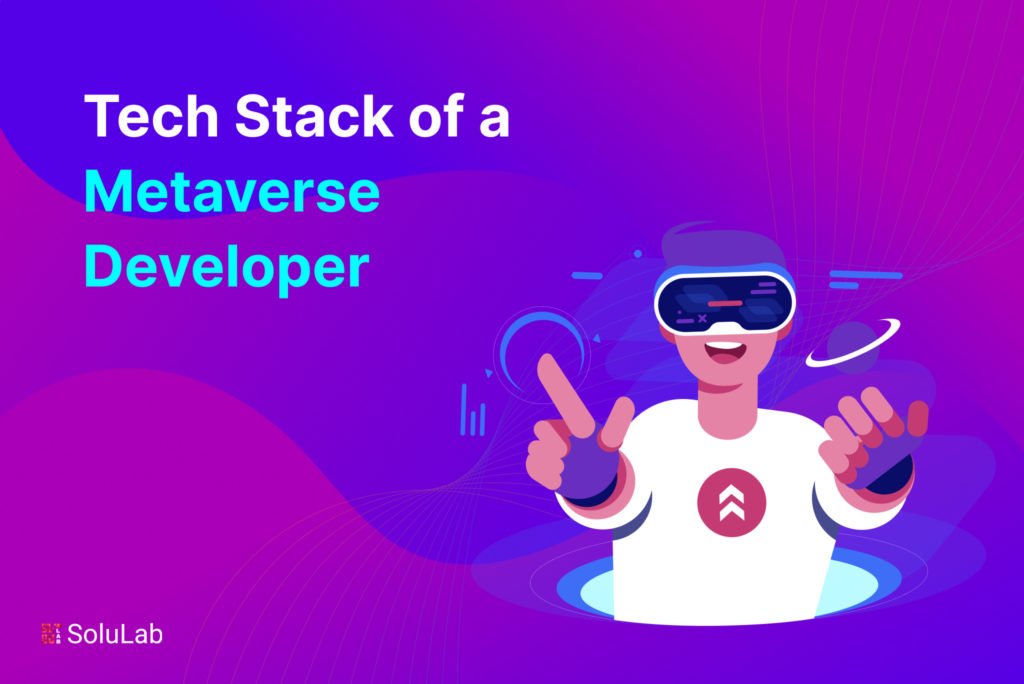
Undoubtedly, The Internet era is evolving quite briskly, and the Metaverse plays a vital role in this evolution. Even though someone is not aware of Metaverse and related terms, they will still have ideas about social media channels and remote working; thus, the popularity of Metaverse is pretty evident.
Known as the 4D version of the Internet, Metaverse is the new form that assembles physical, augmented, and Virtual Reality in the virtual sector.
The idea of Metaverse is not restricted to social media platforms or online games, but the concept is pretty vast. Metaverse’s features include remote work, decentralized government, and digital identity verification. The idea of Metaverse is growing and becoming much more multidimensional as it has mothered many features like networked VR headsets and glasses, which can be used to explore 3D settings.
Now you must be wondering about the technologies that we use in Metaverse; well, to help you out, we have covered the list of crucial technologies that Metaverse requires. Let’s dig deeper.
Virtual Reality
Virtual Reality is one of the most popular Metaverse technologies. It is an experience that imitates realistic situations, and Real-life use cases include gaming, social networking, education, and job training.
With the aid of VR, which sends users to another virtual world from Reality, the Metaverse can potentially interrupt numerous operations further using this technology.
Read Also: Top IoT Development Companies 2023
Nowadays, several platforms help users to connect with other VR users. Facebook Horizons allows users to explore a virtual era where they can connect to others virtually regardless of physical distance and relish the actual meet-ups alike. It also enables you to participate in virtual games and lets you bid bye to boredom by having a virtual presence. The most prominent VR headsets comprise the Oculus Quest, HTC, Vive, Cosmos, Sony, Playstation VR, and Valve Index.
Artificial Intelligence Technology
From avatar creation, and making Digital humans to helping in Intuitive interfacing and Multilingual accessibility, AI technology plays a vital role in the Metaverse. Designing a quality, reliable, and scalable metaverse experience without AI will be challenging.
Artificial Intelligence Technology helps the Metaverse in numerous ways. Artificial Intelligence creates the bridge between robots and humans and thus plays a vital role in designing Digital Humans. In the Metaverse, Digital Humans can be programmed considering real-life stories, motivations, and purposes. With the advancements in the virtual world, there will be times when we can interact in pre-planned situations with these virtual characters and define our scenarios with them.
Read Also: Why the Web 3.0 Matters and You Should Know About It
How is AI important in the Metaverse?
Today, These Digital characters can amazingly display general artificial intelligence.
AI technology often aids developers in restructuring the design and construction of Metaverse assets, such as digital characters, sceneries, structures, and more. In addition to this, it is expected that finding advanced AI capabilities combined with game engines like Unreal Engine is not far.
- In the Metaverse, Artificial Intelligence can systematize software development processes, leading developers to build a progressively complex draft quickly and seamlessly.
- Other than that, Artificial Intelligence can be used to make, assess, and protect contracts on the Blockchain. Fundamentally, these contracts enable trusted transactions and contracts to be approved without the requirement for a central authority or legal approval.
Augmented Reality
Augmented Reality is one of the major technologies used in the Metaverse. Here the designer upgrades the section of the physical world with virtual input. Ultimately, AR contact lenses and AR glasses could augment the world and enable virtual assistants with the assistance of updated artificial intelligence. This AI would aid in directing both real and virtual creations.
Presently, significant and most preferred augmented and mixed reality headsets are Microsoft HoloLens and the Magic Leap One. They’re mainly used for creativity purposes, but you will commonly find AR headsets as AR costs less.
Blockchain Technology
Blockchain technology plays a vital role in Metaverse. It is generally considered an ideal currency for enabling rapid and safe digital connections.
Blockchain is a communal database that consents to manifold parties to immediately access and confirm digital information. 
Know about Blockchain and cryptocurrency-related concepts-
Blockchain technology provides a clear decentralized explanation for digital indication of possession, digital collectability, value transfer, governance, availability, and interoperability between devices. Cryptocurrencies let users transfer data in the 3D digital setting.
Read Our Blog: Web 3 vs Metaverse: What’s The Difference
Brain-Computer Interfaces Technology
Brain-computer interfaces let users manage digital avatars, virtual creations, and several digital transactions with the brain signals. This technology is expected to grow popular in the video game and remote work sectors.
Although companies are developing brain-computer interfaces today, this technology is not the leading know-how used in Metaverse. However, it is expected that soon users will be employing brain-computer interfaces to join the neocortex. The neocortex is part of the human brain’s cerebral cortex, where higher reasoning operations originate.
Web 3.0
Considered the Next-Gen Internet Technology, Web 3.0 is another in the queue. With Web 1.0. Content creators were rare, and most users were coming up as content consumers. For the most part, repeatedly in the Web 2.0 era. Web 2.0 troubles the web as a stage where software applications are constructed.
These empowered users to contribute to content formation on social media platforms, considering blogs, sharing sites, articles, posts, and more. Web 2.0 importantly authorizes central tech majors and allows scrutiny and oppressive advertising.
Web 3.0 has a chief benefit; it allows decentralized blockchain protocol, allowing users to attach to an internet where they can own and be appropriately rewarded for their time and efforts. This is more beneficial than a web where giant central corporations can tap significant revenues on a substantial portion of the web.
Predictably, Web 2.0 will assist processors in comprehending the semantics or senses of paragraphs to generate, share, and connect content, and do search and analysis thanks to semantic metadata. Web 3.0 will help ease better connectivity amid data sources. As a result, the user experience changes to another level of connectivity that influences all accessible data in Cyberspace.
Mobile Device Processors
Another technology would be mobile device processors for augmented Reality. This would need minor superfast mobile processors that can be tailored on normal-looking glasses, VR devices, fast mobile processors to lever realistic graphics, low expectancy, enhanced refresh rates, high frames per second, and more.
As processes need more focus and enough attention to work well, It is also expected to find optical components that will slog with standard Silicon components. This would lead to an increase in data transfer rapidity.
IoT technology in Metaverse
When it comes to the Technologies of Metaverse, IoT technology can’t be skipped. One of the claims of IoT on the Metaverse is to gather and offer information from the real world.
When the experts consider metaverses to the present Internet of Things (IoT), they realize the economy’s acceleration is touching new heights. IoT is often found to connect the 3D setting to many practical devices flawlessly. In the Metaverse, this lets the production of real-time simulations. IoT also uses AI and machine learning assistance to focus on the collected information from the real world to improve the metaverse environment.
The unsettling technology that syndicates AI, 5G, Virtual Reality (VR), and Metaverses altogether is expected to come up as the most significant sector globally. Human Intellect will be rooted in every industry, such as the Microsoft Word service, soon in the near future.
Read Also: Building Worlds Beyond Reality: A Guide to Metaverse Development
The Bottom-Line
As the popularity of Metaverse is increasing, it is expected that it will develop as much as possible in the world with the development of more connected devices.
Undoubtedly, Infrastructure for the Internet of Things and upgraded 5G networks are getting much prioritized, and it is expected to continue to bloat as the year’s roll by. However, it is evident that the Metaverse, an equivalent dominion of the natural world, will develop progressively tangled and become another substitute soon.
While the Metaverse is still in its early development stages, many industries have previously observed its potential, especially in the crypto sector. Although, the primary involved operations are Microsoft, Nvidia, Facebook, and more alike. In addition to this, it is also expected to find novel features in these virtual worlds such as AR, VR, and AI technology.
From Brain-computer interfaces and blockchain technology to IoT technology, this blog covers the list of all those crucial technologies that Metaverse requires. It also considers how these technologies are evolving and the near-future predictions of Metaverses, and we hope this helps!
Conclusion
In the article “Tech Stack of a Metaverse Developer” we delved into the essential components and technologies that make up the metaverse developer’s toolkit. This article highlighted the pivotal role of metaverse developers in shaping the virtual realms of the future. From programming languages like C# and Python to the integration of blockchain and AI, the metaverse tech stack is a dynamic and evolving ecosystem.
As the metaverse continues to gain prominence, it becomes clear that it is not merely a vision of the future but a reality under construction. Developers and enthusiasts alike are exploring the vast potential of this digital universe, paving the way for immersive experiences, decentralized economies, and novel forms of social interaction.
In conclusion, the article sheds light on the multidisciplinary nature of metaverse development and the exciting possibilities it offers. Whether you’re aspiring to become a metaverse developer or simply curious about this emerging field, understanding the tech stack is a vital step toward embracing the limitless possibilities of the metaverse.
Solulab is at the forefront of metaverse development, equipped with a dedicated team of experts who possess a deep understanding of the technologies and tools that power this digital frontier. With a proven track record of delivering innovative solutions, Solulab empowers businesses and entrepreneurs to bring their metaverse visions to life. Whether you’re looking to create immersive virtual experiences or harness the potential of blockchain and AI within the metaverse, Solulab has the expertise to guide you every step of the way. Don’t miss the opportunity to join the metaverse revolution. Contact Solulab today to explore how they can help you transform your ideas into metaverse realities.
FAQs
1. What is a metaverse developer’s role in creating the metaverse?
A metaverse developer plays a crucial role in designing and developing the virtual world of the metaverse, including its infrastructure, interactions, and experiences.
2. What programming languages are essential for metaverse development?
Metaverse developers often use languages like C#, JavaScript, Python, and Rust to create immersive environments and interactive experiences.
3. How does blockchain technology contribute to the metaverse tech stack?
Blockchain technology enhances security, ownership, and interoperability in the metaverse by enabling digital asset ownership and secure transactions.
4. What role do AI and machine learning play in metaverse development?
AI and machine learning are used to create intelligent NPCs (non-playable characters), personalized experiences, and data-driven insights in the metaverse.
5. What are the key components of a metaverse developer’s tech stack?
A metaverse developer’s tech stack typically includes 3D modeling software, game engines, VR/AR tools, and cloud infrastructure for scalability.
6. How can I start a career as a metaverse developer?
To begin a career as a metaverse developer, you should acquire skills in programming, 3D design, AI, and VR/AR technologies, and gain experience through projects and collaborations.
7. What are the future trends in metaverse development technology?
Future trends in metaverse development may include decentralized metaverse platforms, advanced AI-driven experiences, and increased integration of virtual and physical worlds.





